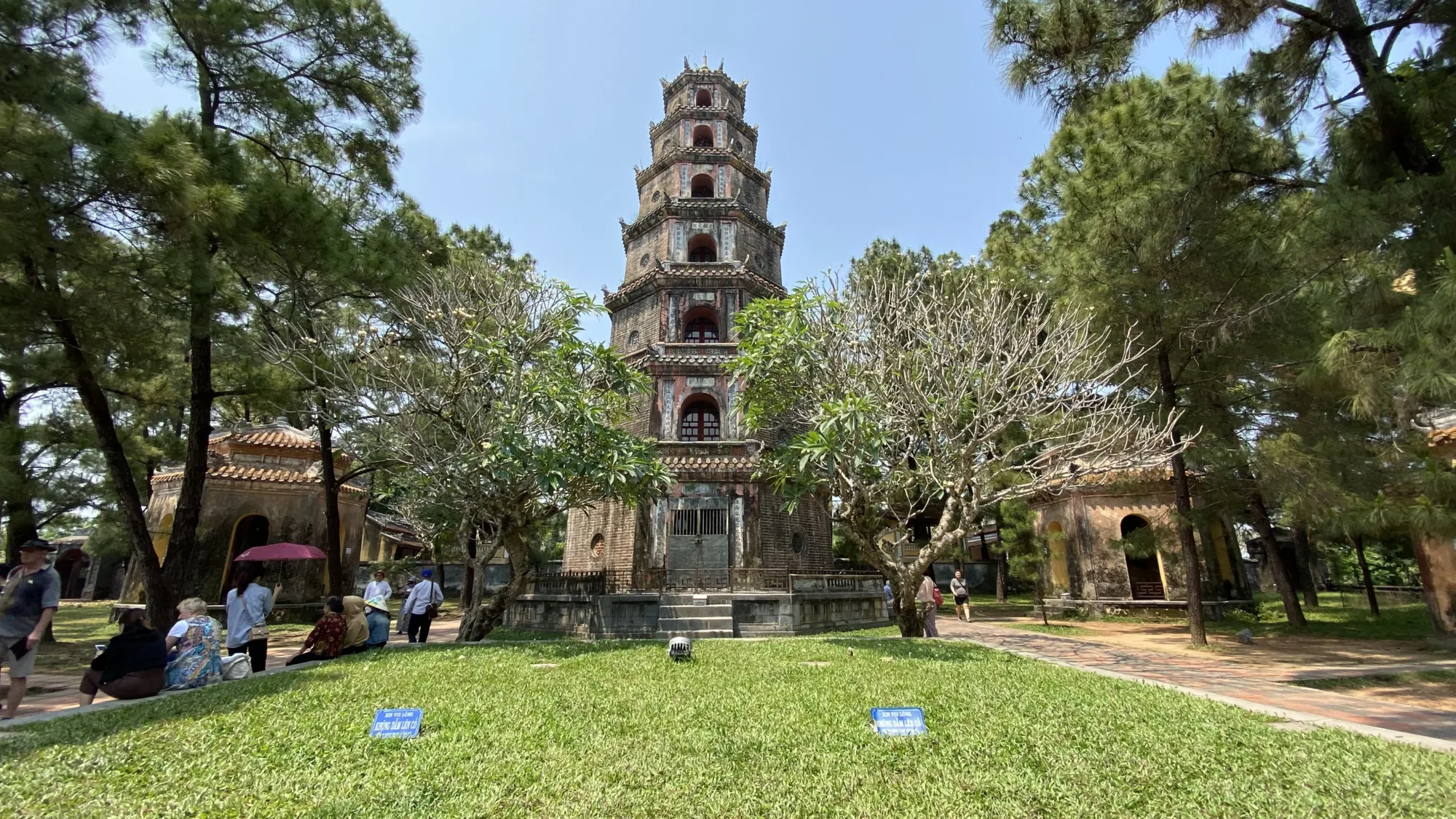As the Perfume River winds through the ancient city of Hue, Vietnam, Thien Mu Pagoda emerges as a beacon of serenity amidst the verdant landscape. Its elegant silhouette against the backdrop of lush hills creates a mesmerizing vista, inviting travelers to embark on a spiritual odyssey through its tranquil grounds.



In that moment, it felt as though the very essence of tranquility had materialized before us, beckoning us to leave behind the cares of the world and immerse ourselves in its sacred embrace.
The sight of the pagoda’s stirred something deep within us, igniting a sense of wonder and reverence that only grew stronger as we drew nearer. It was as if time itself had paused to allow us to savor the beauty of this ancient sanctuary. Moreover, it was inviting us to embark on a journey of the spirit where the boundaries between past and present blur into insignificance. With each step closer to Thien Mu Pagoda, we felt a palpable sense of connection to something greater than ourselves, an invitation to explore the depths of our own souls amidst the serenity of its tranquil grounds.

Unraveling Centuries of History at Thien Mu Pagoda
Setting out on our tour from Da Nang to Hue, my sister and I eagerly anticipated our visit to Thien Mu Pagoda. It is renowned not only for its breathtaking beauty but also for its rich historical significance. Situated on Ha Khe Hill along the northern bank of the Perfume River, Thien Mu Pagoda holds a pivotal place in Vietnamese history. In fact, it serves as both a religious center and a symbol of imperial authority.
Constructed in 1601 by Nguyen Hoang, the first lord of the Nguyen dynasty, the pagoda was initially named “Linh Mu,” or Heavenly Lady Pagoda, after an apparition of Lady Buddha seen on the hill. Over the centuries, it evolved into the grand complex we see today, reflecting the cultural and architectural influences of successive dynasties.

The pagoda stands as a testament to Buddhist faith and imperial power. In fact, its architecture blends traditional Vietnamese design with elements of Mahayana Buddhism. Additionally, Emperor Thieu Tri added its iconic Phuoc Duyen Tower, also known as the Thap Phuoc Duyen, in 1844. Also, its seven stories symbolize the steps to enlightenment.
Throughout its history, Thien Mu Pagoda has witnessed significant events, including protests against religious persecution and political unrest during the Nguyen dynasty. In 1963, the pagoda gained international attention when Thich Quang Duc, a Buddhist monk, self-immolated in protest against the South Vietnamese government’s religious policies, sparking widespread outrage and contributing to the downfall of the regime.



A Glimpse into Tranquil Splendor
Stepping onto the pagoda’s grounds, a kaleidoscope of colors and architectural wonders that whispered tales of centuries past greeted us. The Phuoc Duyen Tower, with its majestic seven tiers symbolizing the path to enlightenment in Mahayana Buddhism, loomed tall and proud amidst the serene surroundings. Moreover, its intricate details telling stories of spiritual ascent and inner peace. Sculptures and motifs depicting Buddhist deities and heavenly realms adorn each tier of the tower. They invite visitors to embark on a journey of introspection and enlightenment as they ascend its heights.
Lush gardens, meticulously tended over generations, sprawled around the pagoda, offering a haven of tranquility amidst the bustling world beyond its walls. Tranquil ponds mirrored the azure sky above, their still waters reflecting the beauty of the surrounding landscape and serving as a metaphor for the clarity of mind sought through Buddhist practice.
Ornate pavilions, adorned with elaborate carvings and vibrant paintings, stood as testaments to the skill of artisans past, each structure a fusion of architectural styles that speak to the pagoda’s rich cultural heritage. As we wandered through the compound, each corner revealed a new marvel, from hidden courtyards adorned with fragrant incense to sacred halls housing ancient scriptures and relics, each offering a moment of quiet contemplation and awe in the presence of something greater than ourselves.


How to Get to Thien Mu Pagoda
Located approximately 4 kilometers southwest of the Hue city center, reaching the pagoda is relatively straightforward. One popular option is to take a scenic boat ride along the Perfume River. Hence, travelers can admire the picturesque views of the riverbanks adorned with lush vegetation and traditional Vietnamese villages. Alternatively, visitors can opt for a leisurely stroll through the surrounding countryside. Furthermore, they can immerse themselves in the tranquil beauty of the rural landscape as they make their way to the pagoda. For those preferring a quicker mode of transportation, taxis and motorbike rentals are readily available in Hue and offer convenient access to Thien Mu Pagoda.
Open daily from dawn till dusk, the pagoda welcomes visitors with no entrance fee, although donations are appreciated to support the preservation of its cultural heritage. Upon arrival, the serene ambiance of the pagoda’s grounds greet its guests. Here, they can explore at their own pace and partake in moments of quiet reflection.



Venturing Outside Thien Mu Pagoda: Exploring Local Treasures
Having immersed ourselves in the spiritual ambiance of Thien Mu Pagoda, we ventured beyond its hallowed grounds to explore the bustling market teeming with local artisans and vendors. Here, amid the vibrant tapestry of Vietnamese culture, we sampled delectable street food and admired traditional crafts. Also, we engaged with the warm-hearted locals, each encounter enriching our understanding of this captivating land.
Our sojourn at Thien Mu Pagoda was a memorable one, a reminder of the enduring power of faith and the beauty of ancient traditions. As we bid farewell to this enchanting sanctuary, we carried with us a renewed sense of peace and purpose, grateful for the opportunity to embark on a journey of discovery in the land of the ascending dragon.

